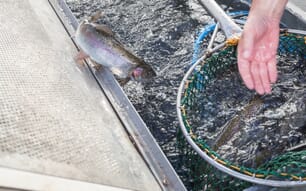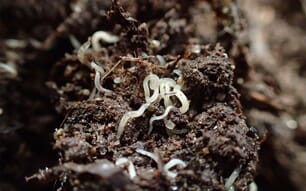Due to the need for vaccination, grading and tagging, the movement of fish between facilities, and slaughter; the capture and handling of fish is often unavoidable. However the removal of fish from water is known to elicit a maximal emergency stress response in the animals, and welfare groups are now advising this should only be completed when absolutely necessary, with animals kept out of the water for no longer than 15 seconds unless anaesthetised (Human Slaughter Association, 2005). Such groups also releasing a series of recommendations about the best practices to be employed on farms, as well as encouraging the industry as a whole, to continually develop less stressful ways of carrying out these procedures.
Capture and Handling
Various methods are used in the capture and movement of fish within farms; ranging from the use of small nets for individual animals to large nets, or seines, for larger fish collection.
Special fish pumps or pipes are also used for the movement of fish between ponds or to separation tanks for treatment.
Each of these methods however, have their associated limitations. The use of nets, for example, can easily cause abrasions and the damage and loss of scales.
Although having the advantage of keeping fish in water, poorly designed pumping systems can also cause fish injury, as fish can often be dropped on to hard surfaces at the point of exit from the pipe.
Once caught, handling is also considered a stressful process, with injuries to eyes, fins and muscle, as well as scale loss are all common, especially in salmon smolts.
Handling is also known to damage the protective mucous coating of the skin, which serves as the primary line of defence against pathogens, thus increasing the vulnerability of fish to disease.
Transport
For certain species, the transport of farmed fish between facilities is a regular and routine part of their production cycle.
Young rainbow trout, for example, are often transported to on-growing farms to be fattened to slaughter weight, and salmon smolts are moved from freshwater sites to seawater cages as they develop; fully grown salmon then often require further transportation to a separate processing plant for their eventual harvest.
Whilst this transport is common and frequent however, the process is extremely stressful for fish and may negatively affect survival rates of the population as a whole. In salmon smolt, for example, it takes more than 48 hours for amounts of the stress hormone, cortisol, to return to pre-transport levels.
There are largely three methods employed for the transport of farmed fish; namely the use of well boats, helicopters and water tanks carried on flat-bed trucks.
Whilst the practice of water tanks is as appears, fish in helicopters are crowded into highly-oxygenated purpose-built water tanks or buckets carried beneath the vehicle and, due to welfare concerns, are restricted to only very short journeys.
In well boats, fish are kept in a pool of seawater within the boat’s hull; the water constantly exchanging with that from the outside by the pressure caused by the motion of the vehicle, or automated pumps when movement ceases. This continual refreshment of the water makes the use of well boats the most preferred method of transport.
However, despite this preference, the transportation of fish by all means causes some form of stress, and injuries are known to be sustained through physical interaction with other animals or concussion with the tank walls.
Further poor conditions during transport, caused by overcrowding or inadequate water quality, associated with limited oxygen or the accumulation of carbon dioxide and ammonia, also cause damage and fish mortality. Whilst stress can be reduced by the use of anaesthesia or sedation, neither of the commonly used compounds of metomidate or clove oil are licensed for use within the EU.
For these reasons, welfare charities remain opposed to the transport of live fish over long distances, instead recommending transport to be kept to an absolute minimum at all times.
Reference: Closed Waters: The Welfare of Farmed Atlantic Salmon, Rainbow Trout, Atlantic Cod and Atlantic Halibut. P. Stevenson, 2007, in association with the Compassion in World Farming and World Society for the Protection of Animals.
November 2013




